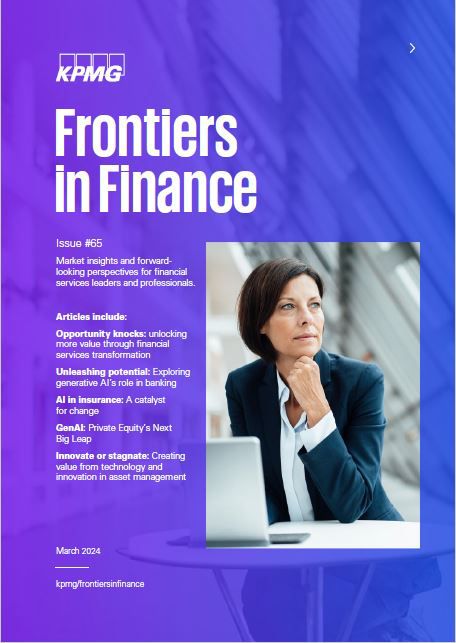Author: Global Head of Financial Services, KPMG International and Head of Financial Services, KPMG in the UK.
Welcome to the latest Frontiers in Finance on the theme of technology and innovation. This edition underlines why I think it’s such an exciting time to be working in the industry — and why this could potentially be the quantum leap for financial services we have been waiting for.
I say potentially because while game-changing technologies like AI are already at our fingertips, others such as quantum computing are only just emerging. These tools are evolving rapidly, demonstrating their potential as catalysts for innovation, transforming processes, and enhancing productivity, efficiency, and performance. More importantly, the data required to feed these new technologies is still on a journey and this is a vital foundational element critical to success.
The articles here highlight the possibilities to reimagine markets and products and move to seamless operating models and customer experiences. With AI and any techenabled change for that matter, there are always new barriers and challenges. So, this edition looks at upsides and downsides of this technology-innovation story.
Data is the cost of entry
While AI’s potential is phenomenal, the cost of entry is data. All the articles, on banking and capital markets, private equity, insurance, and other sectors, reiterate that AI depends on high-quality, well-organized data, backed by a robust data strategy and governance best practices. These are non-negotiables just to compete in the market.
Much like a New Year fitness program, effort and commitment needs to be sustained. Managing data must be continuous to get into good habits. Today’s volume and variety of data creates a pressing need to build a strong culture of data in financial services. Sorting through the data problem can be costly and usually show minimal return in the early stages, but there’s a significant and long-lasting stream of benefits.
Why the ’why’ matters
With financial products already digital, the focus intensifies on faster market delivery. As discussed in the previous Frontiers in Finance, platforms are paramount. Your current model might not be your chosen model for the future. Have you got designs on becoming a primary consumer touchpoint or distributing via intermediaries, such as InsurTech and comparison sites? Could you pivot to a digital-first or digital-only provider or choose Finance-as-a-Service that’s integrated on other digital platforms? Can you embed products into ecosystems, leveraging technologies like IoT, voice control and augmented reality? This array of models and channels presents a paradigm shift in how people interact with financial brands and buy products. As the velocity of business increases, I’d argue it’s
more vital than ever to work out the ‘why’ — why your business is unique, the value you offer and how best to deliver it.
Ultimately, if we assume a world where everything is tech-enabled, your value proposition will be your only differentiator — not the smart tech you’re using or your ultra-efficient processes. It is business-critical to know your real value and to combine it with the right go-to-market model for your brand.
Where best to invest?
AI is a red-hot topic right now, attracting interest at boardroom level as well as increased investment. In fact, it tops the list of technologies in the KPMG global tech survey 2023 — 3 in 5 respondents say that AI (including machine learning and Generative AI) will be the most important technology in achieving their ambitions in the next three years.
For financial services clients KPMG member firms strive to act as a bridge between technology, the business, and the most important aspect — the specific problem you want to solve for. Starting at the nub of the problem gets to the answer more quickly, because once you identify the issues, choosing the right technology mix becomes easier.
I view technology costs and investment in three ways. First, the costs of maintaining and managing legacy technologies and systems not fit for the future. Next, there’s the cost of the specific upgrade and considering what else needs to change. For instance, the expected returns from a new CRM system are achievable only if the sales organization also adopts a more data-driven approach — culture and technology change go hand in hand and must be factored in. Lastly, what’s left behind? When changes are next needed, how easy can you maintain, upgrade, integrate and evolve without adding technical debt. It’s got to be simple for today and simple for tomorrow too.
The right resilience equation
Alongside data, models, and costs, I would underline the challenges of resilience which is an ongoing CEO priority. AI is being used to launch such a high volume of fraud and cybercrime attacks that I’d argue it’s now virtually impossible to avoid — an event targeting your organization is not ‘if’ but ‘when’.
While the clean-up costs of attacks and breaches have risen sharply, that’s only starting to be reflected in the level and type of security investments. Spending is shifting from defense to detection and response. As AI and high-performance computing can be used to filter, detect, and flag issues in real time, the industry will be better equipped to deal with critical questions: how to recover quickly and ensure business continuity.
Some of the articles also show how ecosystems and platforms add extra complexity and risk to the resilience equation. KPMG’s 2023 research highlights the evergreen issues of fraud detection, recovering from cyber-attacks and driving efficiency around reporting and compliance issues. It also evidences a skills shortage. So, part of the technology investment is reskilling — creating homegrown talent in the cybersecurity fraud space.
AI, innovation, and employee experience
Amid any period of rapid innovation, it’s vital to have a heightened awareness of how people may be affected. Thinking about employee experience like customer experience is especially true in the era of AI — it could be a big disincentive to innovate in your role if an outcome is that your job no longer exists. Innovation needs guard rails. So, giving everyone an AI co-pilot and asking them to create something cool will probably just generate chaos.
To find the balance, be clear about the boundaries. Get people focused on what they could do to make their work smarter, faster, and more efficient. Instead of making assumptions, ask people: what do you want and what tools do you need? Some of the answers might be very different to what you imagined, and employees just don’t get asked enough.
At all levels of an organization, I’d encourage a culture where people seize opportunities. Encourage those with the greatest potential to grow and learn — there will be no shortage of learning opportunities in the years ahead, of that I am certain.

Frontiers in Finance: Issue 65
Market insights and forward-looking perspectives for financial services leaders and professionals.
Download magazine (1.9 MB)







